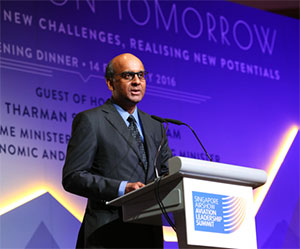As the global aviation industry reshapes itself for the great future of air travel, current economic and other challenges tend to slowdown structural reforms and critical decisions on infrastructure and other key investments crucial to the needed improvements in aviation industry. However, these challenges open the doors for greater cross-border collaboration, cooperation and coordination to effectively improve global interconnectivity, manage security threats, and drive efficiencies in air traffic management.
It offers the opportunity to generate critical mass of future aviation professionals to support the projected growth in all regions. This is the driving force for the Singapore aviation and aerospace industry, which has opened its doors and is reaching out to emerging and developed regions to push for global interconnectivity and coordinated aviation industry development through thought leadership, exchange of technical knowledge and promotion of core aviation investments involving OEMs, MRO and support service providers, training organizations, etc. Singapore has created exemplary innovations and is today adjusting into the future of aviation.
In the ASEAN region, the Singapore ANSP has notably improved its air traffic management capabilities with state-of-the-art facilities like remote control tower and on-going enhancement of ADS-B capabilities to monitor the Singaporean and contiguous FIRs, working with neighbouring States.
Further, Singapore is a key force in the recently established ASEAN Single Aviation Market (ASEAN-SAM) which will multiply aviation growth and benefits in the region; even as Singapore seeks open skies with the EU bloc.
Perhaps, the 'oddly beautiful' thing about Singapore is that, in a world where most governments are aloof, apathetic or slow in responding to the need for aviation development, aviation is made a core part of governance and policy thrust of Singapore, which unites government and industry, which work passionately towards a common vision.
Elsewhere in ASEAN region, China has made aviation connectivity a core part of its One Belt, One Road initiative, where government works with industry for aviation development. Notably, Singapore's commitment to aviation development and providing sustainable environment for growth is akin to the examples in the Middle East, where emerging hubs in Dubai, Abu Dhabi and Doha are diverting to themselves global traffic erstwhile passing through European hubs.
 Mr. Tharman Shanmugaratnam, Singapore's Deputy Prime Minister and Coordinating Minister for Economic and Social Policies, speaking at the opening dinner of the Singapore Airshow Aviation Leadership Summit in February.
Mr. Tharman Shanmugaratnam, Singapore's Deputy Prime Minister and Coordinating Minister for Economic and Social Policies, speaking at the opening dinner of the Singapore Airshow Aviation Leadership Summit in February.
According to Mr. Tharman Shanmugaratnam, Singapore's Deputy Prime Minister and Coordinating Minister for Economic and Social Policies, who spoke at the Singapore Airshow Aviation Leadership Summit in February, 2016, "Aviation plays a special role in our economic future, globally”. Aviation is expected to witness "substantial growth in the next decade, exceeding the growth of Asian economies," he says.
Amidst on-going industry challenges, he sees "opportunity to capitalize on new technologies in every segment of the aviation value chain." He cites the example that "big data can be harnessed for predictive maintenance, and hence lowering costs”. Technology, he says, allows for better analysis of customer habits, and better relationships with customers by personalizing air travel. These ideas are playing out in key aspects of Singapore's aviation system including Singapore Airlines reputed as launch operator of the A380 aircraft and set up low-cost airline and regional partnerships to excel in a liberalized market. The phenomenal Changi Airport which processes 55 million passengers annually, the Singapore Aviation Training School and the State's Air Traffic Services Provider, etc.
Open skies is a core value of Singapore, which strongly believes that "every country can benefit from open skies over the next decade and beyond," noting that protectionism "will not only hamper the growth of aviation but weaken its potential to stimulate economic growth."
Singapore's commitment to innovative technology across the value chain resulted, for instance, the launch by the CAAS of Aviation Challenges to crowd-source for new ideas such as how robotics and autonomous guided vehicles, etc. can be applied. It also resulted to the launch in 2015 of R&D technologies under the National Additive Manufacturing Innovation Cluster, which seeks partnerships with foreign aerospace companies. In this aspect, Mr. Kevin Shum, DG of the CAAS, says Singapore recently signed an agreement with Airbus Helicopters for Unmanned Aircraft Systems Experimentation Project.
Developing for the future, there is massive investment in airport capacity expansion; plans are ongoing "to expand the Changi Airport with a fourth and fifth passenger terminals and a three-runway system." Also recently commissioned is a next-generation air traffic management system designed to effectively manage greater traffic volumes. The CAAS has agreement with AIREON to deploy space-based ADS-B service.
Overall, the strategic development of talent and skills for the future, especially under the National Skills Future initiative which grants awards to individuals in various levels of skills development, is at the cusp of aviation development drives of Singapore. "Wherever you start from, we will help you advance, and keep re-investing in your skills," Mr. Tharman Shanmugaratnam urges Singaporean aviation professionals and potential aviation career seekers. This is one major lesson in capacity development for developing regions.
Roland Ohaeri is the editor of the Aviation and Allied Business Journal based in Nigeria.
This article was originally published in the April issue of the Aviation and Allied Business Journal publication.